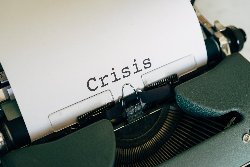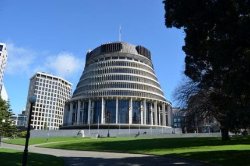Warnings about danger of White Island eruption were ignored
By Tom Peters, Socialist Equality Group
A total of 17
people are now believed to have died in Monday’s volcanic
eruption on White Island/Whakaari in New Zealand. Police
have recovered six bodies from the uninhabited island,
leaving two still missing.
The dead include 10 Australian tourists, plus a family of four who lived in Australia but were originally from Chicago, one Malaysian person and two New Zealand guides employed by White Island Tours. The youngest victims were two brothers, Matthew and Ben Hollander, aged 13 and 16.
Another 21 severely injured people remain in hospital, some of whom may be permanently disabled or disfigured. The victims were exposed to temperatures in the hundreds of degrees Celsius and dangerous gases. All have burns to at least 30 percent of their bodies, while some have burns covering more than 90 percent, as well as burnt lungs.
Every hospital burns unit in New Zealand is full to capacity and some patients are being sent to Australia for treatment. Counties Manukau District Health Board chief medical officer Dr Peter Watson on Wednesday highlighted the unprecedented scale of the injuries. He told the media that “we anticipate we will require an additional 1.2 million square centimetres of skin,” which will be donated by the US. The New Zealand Herald reported that this equates to “about 60 bodies’ worth.”
Some of the victims’ family members have expressed outrage over the horrific disaster. Barbara Barham, whose daughter Lauren Urey and son-in-law Matthew were among the injured, told the Washington Post she was “just livid” that anyone was allowed on the island. “There’s been warnings about it… My son-in-law never would have booked the excursion if he knew there was any chance of them being injured.”
Scientists have been raising questions for years about why tourists were allowed to visit the island and walk into the crater of an active and unpredictable volcano.
Emeritus Professor Ray Cas from Monash University in Australia told Radio NZ on Tuesday that the island’s remoteness from emergency services was a major concern.
The “amphitheatre-like crater,” he said, contained multiple vents emitting noxious gas that could lead to asphyxiation and there was a risk of “sudden overspills of extremely hot water” and “mud flows… with the potential for causing extremely bad burns.”
The banks, where people often stood to take photos, were “unstable [and]… ready to collapse into the crater.” The biggest hazard was the danger of “unexpected, significant explosions even when the alert levels were relatively low… as we saw yesterday.”
Radio NZ interviewer Lisa Owen said that “there is risk associated with many things we do in life and particularly with adventure tourism” and the last deadly eruption on White Island was in 1914. She asked: “The risk is relatively low, isn’t it?” In response, Cas pointed out that “there have been other explosive eruptions in the last two decades, which have occurred at night… So, it’s Russian Roulette if you take people there.” The volcano erupted in 2012, 2013 and 2016.
Erik Klemetti, from Denison University in Ohio, wrote an article for Discover magazine in August 2012 entitled “How Dangerous is Visiting New Zealand’s White Island?” He had the opportunity to visit White Island in 2009 but decided against it because of the risk, despite being interested as a volcanologist.
In a chilling passage, he warned: “For the White Island tours, people are given protective equipment like gas masks and helmets, but if even a small phreatic (steam-driven) explosion were to happen when a group was in the crater, the consequences could be catastrophic. Will it take a half dozen deaths at White Island to change the culture, or is that merely the cost of being adventurous? It is hard to say.”
GNS Science, a government agency, issues advice about risks at the island but has no ability to stop people visiting. That decision is left to tourism operators, which make millions of dollars from volcano tours.
Reportedly, three helicopter companies that visit White Island are not registered for “adventure activities” with the government agency WorkSafe, in violation of regulations. They include Volcanic Air, whose tour group was caught up in Monday’s eruption. A Stuff article noted: “Assessments of adventure tourism operators… looked at whether they gave customers an accurate picture of the dangers they might encounter on a trip.” WorkSafe, however, did not stop the companies from operating without registration.
The Dominion Post drew attention to research from Auckland University of Technology which criticised a “somewhat negligent attitude of [tourism] operators towards safety measures” and a “lack of followup by the governing agencies.” Among the tragic consequences were an overloaded plane crash that killed nine people in 2010 at Fox Glacier, seven people killed in a canyoning trip in 2010, and 11 dead in a hot air balloon crash in Carterton in 2012.
Sections of the media and politicians defended the tourism industry, which is NZ’s largest export earner. Former Whakatane district mayor Tony Bonne told Newstalk ZB on Tuesday that “there’s a lot of different things that humans do that are dangerous,” such as skydiving. The radio station’s right-wing host Mike Hosking declared: “I don’t think there is any blame to be had.” He called the eruption an “act of nature” which “really we have no control over.”
Others tried to divert attention from the Labour Party-led government’s responsibility by heaping praise on Prime Minister Jacinda Ardern. The Herald declared: “The world is yet again praising [Ardern] for her ‘classy’ response to the White Island volcano disaster.” It highlighted a photo of Ardern hugging an emergency worker and quoted a handful of Twitter comments. Newshub published an almost identical article. Academic Jenna Price wrote in Melbourne’s the Age: “Jacinda Ardern is a natural at showing her government cares.”
Every day, however, it becomes more obvious that numerous warnings of a potential catastrophe at White Island, and of blatant safety violations, were either ignored or downplayed by businesses and government regulators. There are striking parallels with the Pike River mine explosion in 2010, where 29 men died. Multiple warnings were made that the mine was a death trap due to multiple safety breaches, but government regulators, trade unions and politicians took no action to prevent a disaster.
Successive National Party and Labour Party
governments, businesses and the union bureaucracy all
promised to improve workplace safety to prevent any repeat
of Pike River. The Labour Department, severely discredited
over its failures at the mine, was rebranded as WorkSafe.
The White Island tragedy, however, demonstrates that a
thoroughly deregulated environment continues to exist,
organised in the interests of profit and placing lives at
risk.


 Binoy Kampmark: The Australian Defence Formula, Spend! Spend! Spend!
Binoy Kampmark: The Australian Defence Formula, Spend! Spend! Spend! Ian Powell: New Hospital Building Trumps ‘Yes Minister’ Hospital Without Patients
Ian Powell: New Hospital Building Trumps ‘Yes Minister’ Hospital Without Patients Mike Treen: Prices Are Still Rising - It's A Cost Of Living Crisis
Mike Treen: Prices Are Still Rising - It's A Cost Of Living Crisis Gordon Campbell: On When Racism Comes Disguised As Anti-racism
Gordon Campbell: On When Racism Comes Disguised As Anti-racism Peter Dunne: Newshub And TVNZ Tip Of Media Iceberg
Peter Dunne: Newshub And TVNZ Tip Of Media Iceberg Harry Finch: Austerity – For And Against
Harry Finch: Austerity – For And Against